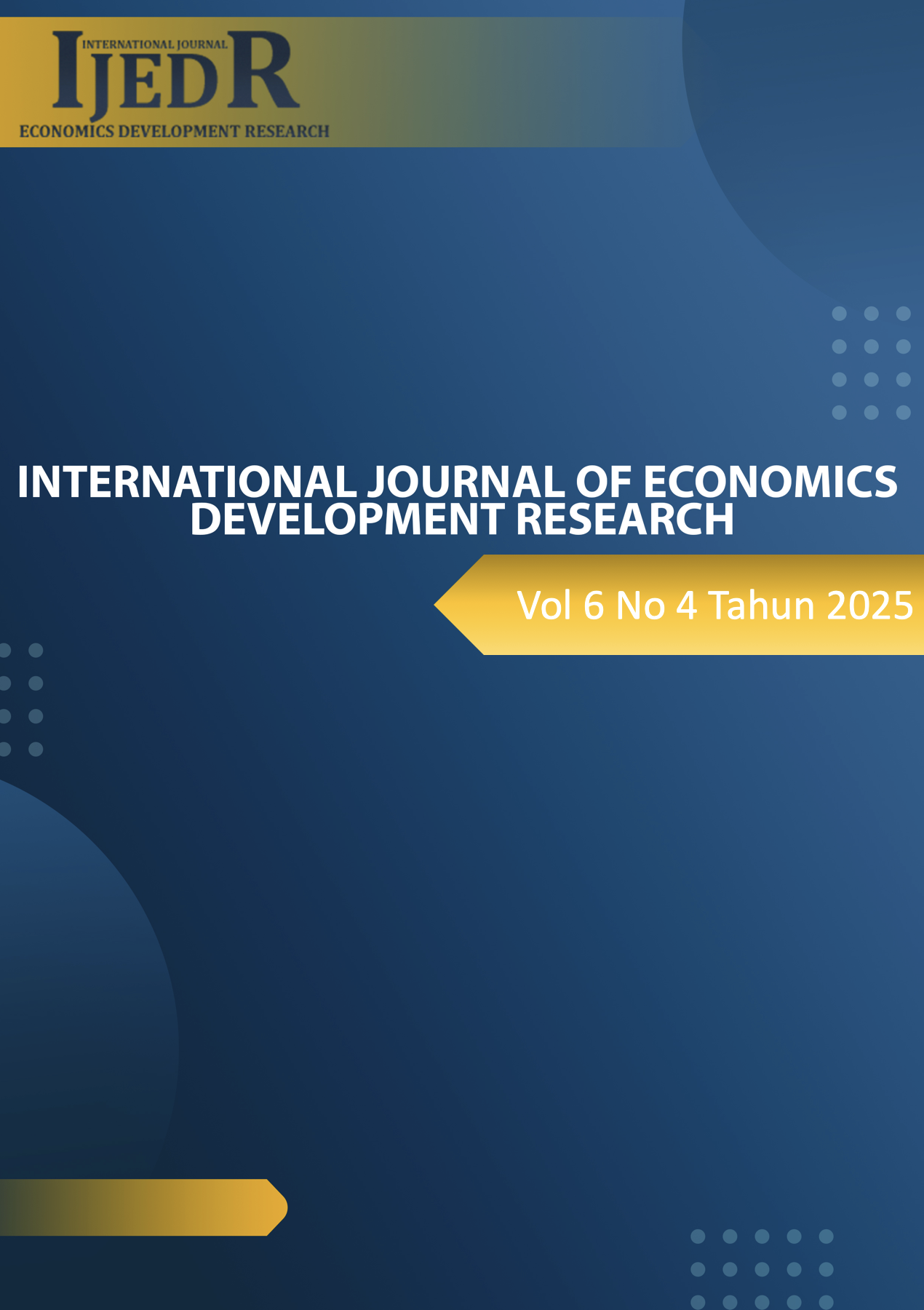Improving Human Development Index (HDI) through Education Spending in Bogor Regency
DOI:
https://doi.org/10.37385/ijedr.v6i4.8033Keywords:
Human Development Index, Expected Years of Schooling, Mean Years of Schooling, Local Government Spending, EducationAbstract
The improvement of the Human Development Index (HDI) in the education dimension heavily relies on the achievements of Expected Years of Schooling (EYS) and Mean Years of Schooling (MYS). Bogor Regency, one of the most populous regions in Indonesia, faces critical challenges in accelerating progress in both indicators. This study aims to analyze the underlying factors of the suboptimal improvement in EYS and MYS through local government spending and to formulate appropriate strategies to enhance the effectiveness and equity of education budget allocation. The research employs a mixed-methods approach using descriptive analysis, SWOT, and the Analytical Hierarchy Process (AHP). Data collection was conducted through document review, in-depth interviews with key informants, and structured AHP-based questionnaires administered to local stakeholders. The findings reveal that the unequal distribution of secondary schools, shortage of civil servant teachers, and limited access to education in remote areas are the primary constraints. The AHP analysis identifies internal weaknesses as the most influential factor hindering educational outcomes. Strategic recommendations emphasize the equitable development of junior secondary schools, capacity-building and equitable placement of teachers, and the advancement of spatial data-driven budget planning systems. The results underscore the necessity for cross-sectoral integration and stakeholder engagement in evidence-based education policy formulation. This study contributes to the development of a more adaptive, participatory, and outcome-oriented strategic framework for regional education development aimed at enhancing the quality of human capital.
References
Al Mamun, T. G. M., & Rahim, M. A. (2025). Public sector efficiency in delivering social services and its impact on human development: A comparative study of healthcare and education spending in India, Pakistan, and Bangladesh. arXiv. https://arxiv.org/abs/2503.12178
Arapova, E. (2022). Role of government expenditures on education in stimulating human development. World Economy and International Relations, 66(6), 53–61. https://doi.org/10.20542/0131-2227-2022-66-6-53-61
Bangun, W. (2021). Pembangunan sumber daya manusia: Teori dan kasus di Indonesia dan negara-negara ASEAN lainnya. Rajawali Pers.
Edward, A. V., Adnan, M. F., & Khaidir, A. (2024). New public manajemen: Studi kasus penerapan New Public Manajemen dalam organisasi publik di Indonesia. Future Academia.
Flynn, N., & Asquer, A. (2022). Public sector management (8th ed.). SAGE Publications.
Gani, I. A., & Nurmiati. (2023). Perencanaan dan pengembangan sumber daya manusia: Teori, kebijakan dan praktik berbasis kompetensi di era digitalisasi.
Ginting, D. Y. br., Ginting, R. br., & Sembiring, D. J. M. (2020). Sistem pendukung keputusan dengan menggunakan metode analytic hierarchy process (AHP). Andi.
Haryanto, A. T., & Siswanta. (2021). Teori pembangunan. Deepublish.
Kulakowski, K. (2020). Understanding the Analytic Hierarchy Process. CRC Press.
Kuncoro, M. (2023). Analysis of modernization theory in the perspective of Rostow’s economic growth theory. Journal of Economic Development Studies, 18(2), 45–67.
Maharda, J. B., & Aulia, B. Z. (2020). Government expenditure and human development in Indonesia. Jambura Equilibrium Journal, 2(2), 95–104. https://doi.org/10.37479/jej.v2i2.6901
Majid, J. (2023). Manajemen sektor publik: Konsep dan teori. CV. Sketsa Media.
Marsono. (2020). Penggunaan metode analytical hierarchy process (AHP) dalam penelitian. In Media.
Nurfitriani, N., & Hartarto, R. B. (2018). Does more spending on education matter to human capital formation? Study case of Bengkulu Province, Indonesia. JKAP (Jurnal Kebijakan dan Administrasi Publik), 22(2), 123–134. https://doi.org/10.22146/jkap.33427
Nurvita, D., Rohima, S., Bashir, A., & Mardalena, M. (2022). The role of public spending on education, health, and economic growth toward human development index in the local economy. Sriwijaya International Journal of Dynamic Economics and Business, 6(2), 197–210. https://doi.org/10.29259/sijdeb.v6i2.197-210
Obuah, E. E., & Komi, G. B. L. (2023). Negotiating with the IMF: The case of Somalia and Jamaica. International Journal of Economic Development, 29(4), 85–102.
Rachmawati, I., & Saputra, R. (2022). Analisis strategi optimalisasi belanja pendidikan terhadap IPM menggunakan AHP. Jurnal Kebijakan dan Anggaran Publik, 5(1), 45–53.
Rangkuti, F. (2017). Teknik membedah kasus bisnis analisis SWOT cara perhitungan bobot, rating, dan OCAI. PT Gramedia Pustaka Utama.
Setyaningrum, D. (2024). Quality education and human development index. International Journal of Economic Policy in Emerging Economies, 17(3), 304–311. https://doi.org/10.1504/IJEPEE.2024.142467
Singh, K., Cheemalapati, S., RamiReddy, S. R., Kurian, G., Muzumdar, P., & Muley, A. (2025). Determinants of human development index (HDI): A regression analysis of economic and social indicators. arXiv. https://arxiv.org/abs/2502.00006
Suhaili, M., Widayati, A., & Fatah, A. (2020). Government investment in the education sector for human capital development. The Indonesian Journal of Planning and Development, 5(2), 58–65. https://doi.org/10.14710/ijpd.5.2.58-65
Widodo, P., Irawan, L. A., Oktavianti, I. N., & Anisa, L. (2021). Government spending on education, health, and minimum wages as predictors of human development index: Study of selected provinces of Indonesia. International Journal of Advanced Economics, 1(2), 45–56. https://doi.org/10.51594/ijae.v1i2.57
Wulandari, D., & Wijaya, Y. (2019). Strategi peningkatan IPM Kabupaten Kediri melalui AHP dan SWOT. Jurnal Ekonomi dan Pembangunan Daerah, 10(1), 55–64.
Yogiantoro, M., Komariah, D., & Irawan, I. (2019). Effects of education funding in increasing human development index. JEJAK: Jurnal Ekonomi dan Kebijakan, 12(2), 345–356. https://doi.org/10.15294/jejak.v12i2.23391





